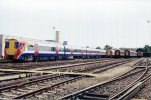I remember well when the 458's came into traffic, I was working in the Control at Waterloo and instead of Juniper they were
nicknamed Junkyard units as that was all they were fit for at the time, it was failure after failure even with travelling fitters
on board didnt help, other than moving the units as Ecs to a depot to clear the running lines.
However they got better, I think that was a result that the staff at Wimbledon Park had a large learning curve to get to know
the units and over the past few years have been the best of the fleets running on SWT.
Quite so, your last two lines above. I was there when they first came in as well, and as shiny and gleaming as they looked parked around the back at WD new sidings, they were still a completely new breed that everyone had to get to grips with.
Roger Ford's annual fleet reliability survey in Modern Railways indicates that they reverted to being SWT/SWRs most unreliable unit since conversion to five cars.
And that was not unexpected by those involved with the project. With any such rebuild, a period of (re) learning and getting to grips with the changes made, by both Fleet engineers and train crew, will inevitably see unit performance drop for some while, before it gradually increases again. That is to be expected with any rebuild scenario, whilst those working with the 'new' version get to grips with the new beasts.
When the units did their last round of C exams at Bournemouth in old 4 car 458 format, when the internal floors were lifted (which proved a real headache in some cases), some vehicles did not look good even then, and this was proved the case when they went to Wabtec for the conversion. There was a serious case of tin worm in a good many cars, similar to the 460 cars that had been stored in the open at Stew Lane, which had been subject to serious water ingress due (in part) to certain aspects of the design of the vehicles.
The result of this corrosion alone, was a major delay factor in the re-introduction as 5 car units, despite additional resources (a second team of bodies) being thrown at the project at that point in time. This then delayed the planned reintroduction to service, and the knock-on delays and reworking of the associated stock cascades that the planners and controllers had to deal with at very short notice.
With the best 'will' in the (engineering) world, corrosion repairs only last so long. Once clean steel has been cut in to, our lovely climate will do it's worst, and any subsequent repairs will be shorter lived than the previous repairs, which may have cause for concern in the here and now.....I know-eth not !

